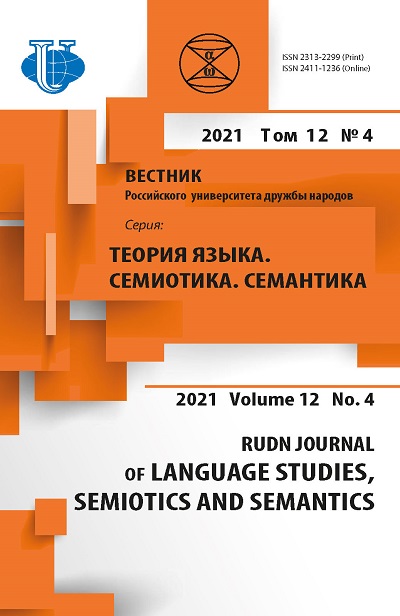Twelve Chinese Zoosigns of Zodiak: Tradition and Modernity
- 作者: Denisenko V.N.1, Zheng Y.X.1
-
隶属关系:
- Peoples’ Friendship University of Russia (RUDN university)
- 期: 卷 12, 编号 4 (2021)
- 页面: 1299-1313
- 栏目: SEMIOTIC STUDIES
- URL: https://journal-vniispk.ru/2313-2299/article/view/323348
- DOI: https://doi.org/10.22363/2313-2299-2021-12-4-1299-1313
- ID: 323348
如何引用文章
全文:
详细
The work is devoted to the origins and peculiarities of zodiac signs in the ancient Chinese tradition. The study is carried out within the frames of linguocultural approach towards interpreting animalistic metaphors, namely, the zoonyms of the twelve zodiac signs which in China, are used to characterize people concerning their date of birth and are passed on from generation to generation. Chinese zodiacs are based on the astronomic theory of constellations and human worship (idolatry) of totems. It focuses on the comparison of zoonym metaphors reflected as Chinese zodiac signs both in the Chinese and Russian languages proceeding from the theory of metaphor in modern cognitive aspect to detect similarities and differences, and as well, the study of cultural roots of zoonym metaphors revealed in the Chinese zodiac signs. The object of the study concerns zoonyms of zodiac signs possessing the relevant meaning in the Chinese zoological lexis. The work elaborates the definition of the notion “zodiac”, describes the processes of the genesis, formation and development of the Zodiac culture and its specific cultural relevance; according to the analysis undertaken, the means to differentiate twelve animals of the Chinese Zodiac, and those of Chinese fairy tales, on the one hand, and, on the other hand, in Russian - animals were discussed and verified as to I.A. Krylov’s fables. The conclusion states that metaphors are determined by the language itself, and linguocultures of various nations are reflected in specific metaphors and other peculiarities.
作者简介
Vladimir Denisenko
Peoples’ Friendship University of Russia (RUDN university)
编辑信件的主要联系方式.
Email: denisenko-vn@rudn.ru
ORCID iD: 0000-0001-6021-4068
Prof. Dr.Sc. (Philology), Professor, Professor-Consultant of the General and Russian Linguistics Department, Philological Faculty
6, Miklukho-Maklaya str., Moscow, Russian Federation, 117198Yu Zheng
Peoples’ Friendship University of Russia (RUDN university)
Email: 1042198008@rudn.ru
PhD student of the General and Russian Linguistics Department, Philological Faculty
6, Miklukho-Maklaya str., Moscow, Russian Federation, 117198参考
- Encyclopedia of China (2009). Beijing: Chinese publishing House “Encyclopedia”. pp. 20-162. (In Chinese).
- E, Shuxiang (1998). The Zodiac Culture and its origins. In: Search of the Roots. Beijing. (In Chinese).
- Wang, Hong-Qi (1992). Remarkable Culture and the Chinese Zodiac Games. Beijing: Sangliang. (In Chinese).
- Zhang, Hao, Yao, Wei-Jun & Ju, Hangqian. (2001). The Chinese Zodiac. In: Education of Hubei Province. Wuhan. (In Chinese).
- He, Xing-Liang (1985). Totemic Culture and The Origins of Human Cultures. Beijing: Chungo Shehui Kesue. (In Chinese).
- The Beautiful Pictures of the Chinese Zodiac Signs and Words (1990), Mu Tziming & Fan Zhou (Eds.). Beijing: “Blue Sky” Publishing House. pp. 3-9. (In Chinese).
- Zhon, Hoe (2005). Twelve Signs of the Zodiac and Life. In: Chinese Business Press. pp. 1-15. (In Chinese).
- Li, Shijia (2005). The Mysterious culture, Numbers and Zodiac Signs. Hainan: Hainan University Press. (In Chinese).
- Lu, Yaohang (1986). The October Calendar of the Civilized China. Yunnan: The Yunnan Peoples’ Publishing House. (In Chinese).
- U, Yujchen (2004). The Culture of the Chinese Zodiac. Tianjin: The Tianjin Peoples’ Publishing House. pp.19-25. (In Chinese).
- Series: “The Chinese Zodiac Culture” (2010). Beijing: Foreign Languages Press. pp. 4-30. (In Chinese).
- Li, Tziming (2008). The Ox as a Zodiac Sign. Beijing: “Slon” Publishing House. pp. 35-40. (In Chinese).
- Krylov, I.A. (1945). Complete Works. Vols. I-III. Moscow: Goslitizdat Publishing House. (In Russ.).
补充文件








